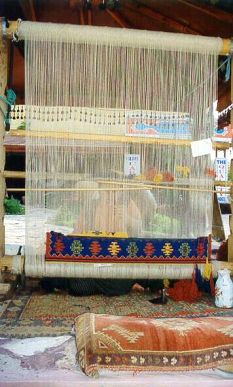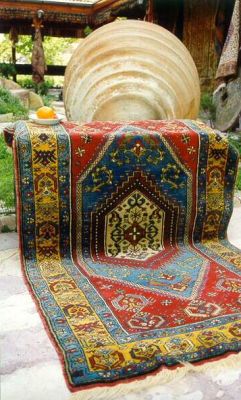
Arts
| In the past, carpets were made by nomads and they were valuable because they enabled them to protect themselves from the cold and the damp, wherever the camps were. Carpets replaced animal skins which quickly got worn out or torn. They could also be used as blankets or matresses. Other types of carpets, called kilims, were made to be used as curtains separating two parts of a tent or to cover cradles. Throughout the centuries, they were used by nomads and little by little, sedentary people started using them in their houses. Carpets gradually came to be the same size and became appreciated for their aesthetic rather than practical qualities. |

In the Middle Ages, quality carpets were made to decorate palaces in Asia as well as in Europe. Renaissance paintings by Gentile, Giovanni and Bellini feature carpets.

Carpets are made on a weaving loom, which is a sort of woodden frame. The threads for the weft are placed vertically, next to each other, according to the width of the carpet. On these threads, the warp threads are spliced or woven after making a 2 to 4 cm woven border round the edge. The weaver ties the balls of cotton, wool or silk, as well as the patterns that will be used, to the wooden frame. A carpet is made from bottom to top and the part that has been woven is drawn behind the weaving loom. The knots are tamped down with a special comb and the threads'ends are cut according to the thickness of the carpet. To finish a carpet, a new woven frame is added round the edge. The carpets are then cleaned with soap and water. |
| Gallery | History | Homes | Arts | Links | Hotels | Factories |